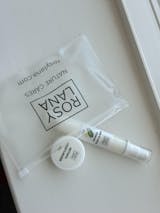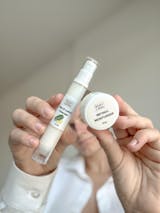The Real Effects of Retinol on Anti-Aging and Hydration – Backed by Science
Retinol is a powerhouse ingredient in anti-aging skincare, proven to reduce wrinkles and improve skin hydration over time.
Retinol has long been hailed as a gold-standard ingredient in anti-aging skincare, but does it live up to the hype? According to extensive clinical research and dermatologists, the answer is a resounding yes. Retinol (a form of Vitamin A) is actually the first vitamin the FDA approved as an anti-wrinkle agent, thanks to its ability to visibly improve the skin’s surface and slow signs of aging
. In this post, we’ll explore the latest credible research on retinol’s benefits for reducing wrinkles, smoothing skin texture, and boosting hydration. We’ll cite peer-reviewed studies and expert dermatology insights to show the real proof that retinol works, and explain how to incorporate this evidence-backed ingredient into your skincare routine for best results.
Retinol: The Science-Backed Anti-Aging Powerhouse
Dermatologists often refer to retinol and its stronger prescription cousins (retinoids) as the most studied anti-aging compounds in skincare
. Retinol is a vitamin A derivative that increases cellular turnover and boosts collagen production in the skin. This increased collagen is a key reason retinol can smooth fine lines and wrinkles
. In fact, Harvard medical experts note that retinoids (like retinol) reduce wrinkles by stimulating collagen and even help form new blood vessels for improved skin tone
. Retinol is gentler than prescription retinoids but still yields significant benefits over time, which is why it’s widely recommended by dermatologists as a foundational anti-aging skincare ingredient.
Not only does retinol fight wrinkles, it also addresses other signs of aging. It fades age spots and softens rough patches, giving skin a smoother texture
. Unlike many trendy skincare fads, retinol’s benefits are backed by decades of research. The American Academy of Dermatology and other experts consistently highlight retinol for those looking to treat fine lines, uneven texture, and mild pigmentation issues in a skincare routine
. In short, retinol has earned its reputation as an anti-aging powerhouse through solid science.
Real Results: How Retinol Reduces Wrinkles and Fine Lines
The evidence for retinol’s wrinkle-reducing effects is compelling. Multiple peer-reviewed studies and clinical trials have shown that retinol use leads to visible improvements in wrinkles:
-
Fewer wrinkles with consistent use: In a gold-standard randomized controlled trial, 0.4% retinol lotion applied 3 times weekly for 24 weeks significantly reduced fine wrinkles compared to a placebo lotion
. The retinol-treated skin had an obvious decrease in wrinkle scores (-1.64 on a severity scale) while the placebo saw almost no change . Importantly, biopsies confirmed why: the retinol boosted new collagen production in the skin. -
Noticeable improvements in 8–12 weeks: You don’t necessarily have to wait six months to see results. A 2019 study on 84 women found that applying a retinol cream twice daily led to significant reductions in neck wrinkles after just 8 weeks, with even greater improvement by 12 weeks
. In this study, the retinol users saw neck lines visibly soften, while a control group using a retinol-free cream saw no change . Even two weeks after stopping retinol, the improvements in wrinkles were maintained, suggesting retinol helped actually repair the skin for longer-term effects . -
Eye wrinkles and fine lines: Another trial reported that wrinkles around the eyes (“crow’s feet”) became less apparent after 8 weeks of nightly retinol use
. By 12 weeks, women using retinol had smoother skin around their eyes and noted an overall more youthful look. This aligns with dermatologists’ observations that retinol can significantly improve fine lines with consistent nightly application over a few months.
What makes retinol so effective against wrinkles? On a cellular level, retinol essentially teaches aging skin cells to behave like younger, healthier cells. It stimulates collagen and elastin production to firm the skin, and it inhibits enzymes (like MMPs) that break down collagen
. Over time, this means the skin’s support structure becomes stronger and wrinkles are “filled in” from beneath. Retinol also thickens the epidermis (the outer skin layer) by accelerating cell turnover
. As old, dull cells are shed and new cells come to the surface, fine lines appear smoother and skin tone looks more even.
It’s worth noting that higher concentrations of retinol may work faster or more dramatically on wrinkles. A 2023 clinical study comparing various strengths found that a higher concentration retinol (approx. 0.5% and above) produced greater improvements in wrinkles and skin firmness, while lower concentrations (around 0.1%) still worked but more gradually
. This means if your skin tolerates it, upgrading to a mid-strength retinol could lead to firmer, line-free skin sooner – though even beginner retinol products will yield results with patience.
Smoother Skin Texture and Hydration Benefits
Beyond battling wrinkles, retinol is prized for improving overall skin texture and even boosting hydration (despite its reputation for sometimes causing initial dryness). Here’s what research and experts say about retinol’s broader skin benefits:
-
Smoother, more even texture: By speeding up cell turnover, retinol acts like an exfoliator from within, unclogging pores and sloughing off rough, dead skin. Harvard experts note that retinoids soften rough patches and even out pigmentation, giving photo-aged skin a smoother look and feel
. Many users notice that retinol makes their complexion look more radiant and even-toned over time, as newer, healthier cells replace the old. In the neck wrinkle study mentioned above, participants not only had fewer lines but also observed that their skin texture became more smooth and supple after 8–12 weeks of retinol use . -
Increased firmness and elasticity: By rebuilding collagen and even stimulating elastin, retinol can make skin feel bouncier and more resilient. One long-term study noted improvements in dermal density and elasticity with regular retinol application, meaning the skin’s underlying structure became firmer
. This translates to a subtle “lifting” effect – think tighter pores, less sagging, and a more youthful springiness in the skin. -
Boosts skin’s natural hydration: It might sound contradictory (since retinol’s side effects include dryness), but research shows retinol actually helps hydrate the skin from within. In the 24-week study on elderly skin, scientists found retinol significantly increased the skin’s content of glycosaminoglycans (GAGs)
. GAGs like hyaluronic acid act as natural humectants – they bind large amounts of water in the skin, keeping it plump and moist. Essentially, retinol prompted the skin to produce more of its own moisturizing molecules. Another study confirmed that retinol triggers more hyaluronic acid production by activating genes called HAS (hyaluronic acid synthases) in skin cells . After a course of topical retinol, biopsies showed higher levels of hyaluronic acid in the skin compared to untreated skin . This explains why retinol-treated skin often looks more hydrated and plump, once it adjusts to the initial irritation period. -
Stronger skin barrier: Retinol also strengthens the epidermis over time, which reduces transepidermal water loss (TEWL)
. By encouraging the production of new skin cells and lipids, retinol helps reinforce the skin’s protective barrier. A more intact barrier means less moisture leaks out, so skin maintains its hydration better. One review noted that retinoids “restrain transepidermal water loss” and improve the skin’s protective function . In simpler terms, once your skin adapts, retinol can actually make it less prone to dryness by thickening the outer layer and boosting natural moisturizers.
Real-world effect: Many people report that after several months on retinol, their skin not only appears more youthful (fewer lines, more even tone) but also feels softer and more “bouncy” or hydrated. The science backs this up – from increased GAGs and hyaluronic acid to stronger barrier function. If dryness is a concern, using a good moisturizer alongside retinol (more on that below) can mitigate the short-term flakes while these long-term hydration benefits kick in.
Dermatologists Weigh In: Why Retinol Deserves a Place in Your Routine
Dermatologists consistently sing retinol’s praises because they’ve seen the results firsthand. “Retinol has been a go-to skincare solution for decades — some might even say the gold standard,” says Dr. Zakia Rahman, a dermatology professor at Stanford
. She explains that retinoids (including retinol) have multiple anti-aging benefits: “They increase the production of natural chemicals (such as hyaluronic acid) in your skin that keep it plump and moist. They stimulate collagen production and inhibit the breakdown of collagen that already exists.”
With this one ingredient, you get a trifecta of skin improvements – more hydration, more collagen, and faster cell turnover – which is why experts consider it unrivaled in the anti-aging arsenal.
Dermatologists also stress that these improvements are well-documented in research. You’re not just seeing a temporary plumping or masking of wrinkles; retinol is actually remodeling the skin on a cellular level. For example, Dr. Rahman notes that retinoids “thicken the epidermis” and “block inflammatory pathways” that can lead to acne and damage
. This means smoother texture and clearer skin, on top of the wrinkle reduction.
Of course, dermatologists will also caution that retinol is not an overnight miracle – you need to use it consistently and correctly. Most people start to see visible improvements in 3 to 6 months, with even better results at 6 to 12 months of continuous use
. These changes then need to be maintained with ongoing use; if you stop using retinol, your skin can gradually return to its baseline (since we can’t stop the aging clock entirely). The good news is that retinol’s benefits accumulate the longer you use it. Many dermatologists have patients in their 40s, 50s, and beyond with incredible skin quality, largely attributed to having used retinoids for years as part of their regimen.
Dermatologist tip: “Introduce retinol slowly and use a moisturizer,” experts advise, to navigate the initial adjustment period
. It’s normal to experience some dryness, redness, or flaking in the first few weeks – a process often dubbed the “retinol purge” or retinization. Dermatologists reassure that this is temporary. “The peeling effects will go away in a few weeks, but all the beneficial effects will remain,” Dr. Rahman says
. To minimize irritation, she often has patients buffer retinol with a hyaluronic acid or ceramide moisturizer (applying the moisturizer right after the retinol, or even mixing them)
. This helps keep the skin hydrated and calm while still allowing the retinol to do its work.
The consensus from skin experts is clear: retinol truly works for anti-aging and skin renewal. If you’re serious about treating fine lines or improving your skin’s texture, virtually every dermatologist will recommend a retinol or prescription retinoid as part of your routine. As long as you use it correctly, the payoff in smoother, firmer, more hydrated skin is well worth the initial patience.
How to Incorporate Retinol Into Your Skincare Routine
Ready to get those retinol benefits for yourself? Here are some dermatologist-recommended steps for adding retinol to your skincare routine effectively:
-
Start low and slow: If you’re new to retinol, begin with a lower concentration (typically 0.3% or even 0.25% to 0.5% for an OTC product) and apply it just 1–2 nights a week. As Harvard dermatologists advise, use retinol “every other day at first” to let your skin acclimate
. A pea-sized amount is plenty for your whole face. Gradually increase to nightly usage over several weeks or as your skin tolerates. Patience is key – rushing it can cause unnecessary irritation. -
Apply to clean, dry skin at night: Retinol should be applied at night because it can make your skin more sun-sensitive (and the ingredient itself can degrade in sunlight). After cleansing and fully drying your face, apply your retinol cream or serum. Some dermatologists suggest waiting a few minutes after washing to ensure your skin is completely dry, which can reduce irritation.
-
Moisturize and hydrate: Always follow up with a good moisturizer after applying retinol. This helps counteract dryness and supports your skin barrier. You can even sandwich your retinol by moisturizing before and after application if you have very sensitive skin. Look for a moisturizer with hyaluronic acid, ceramides, or niacinamide to boost hydration and soothe the skin. Keeping your skin well-moisturized will enhance that plump, hydrated look as retinol works its magic.
-
Don’t skip the sunscreen: In the morning, wear broad-spectrum sunscreen (SPF 30 or higher) every single day. Retinol makes your skin more prone to UV damage initially
, so sun protection is non-negotiable. This also ensures you’re not undoing your hard-earned results – UV exposure is a major cause of wrinkles and dark spots, so sunscreen and retinol together are the ultimate anti-aging duo. Apply sunscreen as the last step of your morning routine (after any daytime moisturizer or serum), and reapply during the day if needed. -
Be consistent and give it time: Retinol’s effects build up with consistent use. Make it a regular part of your nightly skincare routine. Set realistic expectations – most studies show noticeable improvements by 8–12 weeks, with increasing benefits up to 6+ months
. Stick with it; the payoff is smoother, younger-looking skin that lasts. If you experience irritation that doesn’t subside after a few weeks, consult a dermatologist – they might adjust your frequency or switch you to a lower strength until your skin adjusts. -
Consider your skin’s needs: If you have specific concerns like deep wrinkles or very dry skin, you might eventually graduate to a higher-strength retinol or even a prescription retinoid (like tretinoin) under a dermatologist’s guidance. On the other hand, if you have very sensitive skin, you might do better using retinol just 1-2 times a week long-term, and that’s okay – you’ll still get benefits at that pace. Pregnant or breastfeeding women should avoid retinol (or check with a doctor), and instead opt for alternatives until they can use retinol later on.
By following these steps, you can safely integrate retinol into your skincare routine and maximize its anti-aging and hydration benefits. Many night creams and serums on the market contain retinol – from gentle drugstore options to professional-grade formulations. When choosing one, look at the percentage of retinol and start with what matches your experience level. For beginners, a product around 0.3% is a great starting point; intermediate users might use 0.5%, and advanced users or those who have tolerated retinol well can try 1.0%. Always remember, consistency matters more than high percentage – a moderate retinol used regularly will outperform a strong one used inconsistently.
Conclusion: Real Proof that Retinol Works
In summary, retinol’s anti-aging benefits are real and well-proven. Peer-reviewed studies show significant wrinkle reduction, firmer skin, and even improved hydration in retinol-treated skin
. Unlike many cosmetic ingredients that offer only temporary effects, retinol triggers actual renewal within the skin – boosting collagen, elastin, and hyaluronic acid to revive your complexion from the inside out
. Dermatologists and research scientists alike agree that retinol can visibly reduce fine lines and wrinkles, smooth out rough texture, fade dark spots, and give skin a more youthful, plump appearance with consistent use
.
Perhaps most importantly, retinol has the endorsement of major dermatology organizations and medical institutions. The evidence isn’t just anecdotal – it’s documented in journals and clinical trials, making retinol one of the few skincare ingredients with such authoritative backing. If you’re looking to invest in your skin’s future, a quality retinol cream or serum is an excellent addition to your nightly routine. Used properly, it can take your anti-aging and hydration results to the next level.
While retinol is powerful, remember that great skin care is also about balance: hydrate your skin, protect it from the sun, and be gentle while the retinol does its work. Over time, you’ll reap the rewards of brighter, smoother, younger-looking skin – and you’ll have the science on your side. With real proof that retinol works, it’s no surprise this ingredient remains the cornerstone of anti-aging skincare routines worldwide. Here’s to glowing, healthy skin!
References: Clinical studies and expert sources have been cited throughout this post to ensure information is credible and trustworthy. Key references include published research in dermatology journals and statements from dermatology experts and associations, demonstrating the proven benefits of retinol in skincare





